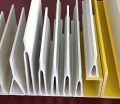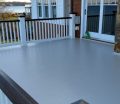Fiberglass oak beams are an innovative solution for homeowners seeking the aesthetic appeal of traditional oak without the challenges of maintenance and weight. These beams are constructed from fiberglass, a lightweight yet durable material that closely mimics the natural grain and texture of real oak. Similarly to fiberglass bridge beams, which are designed for strength and durability in harsh conditions, fiberglass oak beams are resistant to moisture, warping, and termites, ensuring longevity and minimal upkeep. They are ideal for ceiling installations, offering the charm of oak with the practical benefits of fiberglass. Fiberglass oak beams can transform any space, combining timeless elegance with modern performance, making them a superior choice for both classic and contemporary designs. Fiberglass oak beams are durable, warp-resistant, termite-proof, and easy to install, offering long-lasting, low-maintenance solutions for ceilings.
What are Fiberglass Oak Beams?
Fiberglass oak beams are a modern innovation in construction materials, combining the visual appeal of traditional oak with the strength, durability, and low-maintenance properties of fiberglass. These beams are designed to mimic the look and texture of real oak, offering the same warm and rustic aesthetic that oak beams provide. However, unlike real oak, fiberglass oak beams do not suffer from issues such as moisture absorption, rotting, warping, or pest infestations, making them ideal for both indoor and outdoor use in various climates and conditions.
GangLong Fiberglass manufactures high-quality fiberglass oak beams that can be customized in terms of size, finish, and texture to fit the specific needs of any project. These beams are lightweight, easy to install, and require minimal upkeep, making them a practical alternative to real oak beams for homeowners, builders, and designers looking for a durable and cost-effective solution that still delivers on visual appeal.
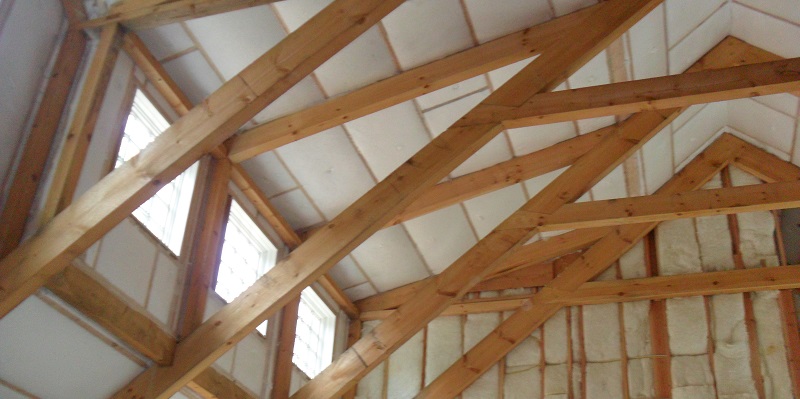
The Strength of Fiberglass Oak Beams for Load-Bearing Applications
While the primary appeal of fiberglass oak beams is often their aesthetic similarity to real oak, they are also highly functional in load-bearing applications. Fiberglass is a material known for its high strength-to-weight ratio, meaning that fiberglass oak beams can support significant loads without the risk of bending or breaking. This makes them suitable for use in structural applications where support and stability are critical.
GangLong Fiberglass produces fiberglass oak beams that are engineered to meet the specific load-bearing requirements of each project. These beams are lightweight compared to traditional materials like solid oak or steel, which reduces the overall weight of the structure and simplifies installation. Despite their lightness, fiberglass oak beams provide the necessary strength to support roofs, floors, and other architectural features.
The Durability of Fiberglass Oak Beams in Construction
One of the most significant advantages of fiberglass oak beams is their durability. Traditional oak beams, while strong and aesthetically pleasing, are susceptible to a range of environmental factors that can compromise their structural integrity over time. These include moisture, humidity, insects, and temperature fluctuations, all of which can cause real wood to rot, crack, or warp. Fiberglass oak beams, on the other hand, are resistant to these issues, providing long-lasting support and maintaining their appearance without the need for extensive maintenance.
Fiberglass is a material known for its strength and resistance to external elements. This makes fiberglass oak beams an excellent choice for outdoor applications, such as porches, pergolas, or exposed beams in exterior construction, where they will be subjected to weathering. GangLong Fiberglass offers beams that are specially designed to resist UV rays, moisture, and temperature changes, ensuring that they remain structurally sound and visually appealing for many years.
Fiberglass Reinforced Glue Laminated Beams in Architecture
Customization Options for Fiberglass Oak Beams
Fiberglass oak beams are highly customizable, allowing architects and designers to tailor them to fit the exact specifications of a project. Whether you are looking for beams that replicate the grain and texture of real oak or prefer a more modern, smooth finish, fiberglass can be molded and finished to achieve a wide range of aesthetic effects.
GangLong Fiberglass provides various customization options, including different sizes, shapes, and finishes. These beams can be designed to look like aged, weathered oak or have a polished, freshly cut wood appearance. Additionally, fiberglass oak beams can be painted or stained to match the color palette of the space they are being installed in, offering endless design possibilities. Whether for use in rustic, traditional settings or modern architectural designs, fiberglass oak beams offer flexibility in both form and function.
How about Customizing Fiberglass Oak Beams?
Another advantage of fiberglass oak beams is their customizability. Homeowners can choose from a wide range of finishes and colors to match their personal style or the existing decor of their home. Whether it’s a rich dark oak finish or a lighter, more contemporary look, fiberglass oak beams offer options that cater to various aesthetic preferences.
In addition to finishes, fiberglass oak beams can be customized in terms of size and shape. This means that whether a project calls for large, bold beams to make a statement, or smaller, more subtle beams for a delicate touch, fiberglass oak beams can be made to order. The flexibility in design also extends to different beam styles, including box beams and hollow beams, which can be used to conceal wires, pipes, or other structural elements.
What is Fiberglass Oak Beams in Home Design?
Fiberglass oak beams are an innovative solution that brings the classic, timeless appearance of oak wood to modern home interiors without the limitations of traditional wood. These beams replicate the look of oak but are made from fiberglass, offering several advantages that enhance their appeal. From lightweight construction to easy installation, fiberglass oak beams offer a perfect alternative for those who seek the aesthetic of oak without the drawbacks of maintenance and weight.
Fiberglass oak beams are commonly used in various spaces, including living rooms, kitchens, and hallways, to create a rustic or traditional ambiance. The versatility of these beams makes them an ideal choice for anyone looking to add character to their home. Their ability to mimic natural oak while being more affordable and easier to handle sets fiberglass oak beams apart from traditional wooden beams. Let’s explore how they can transform interior spaces and why they are becoming a popular choice in home design.
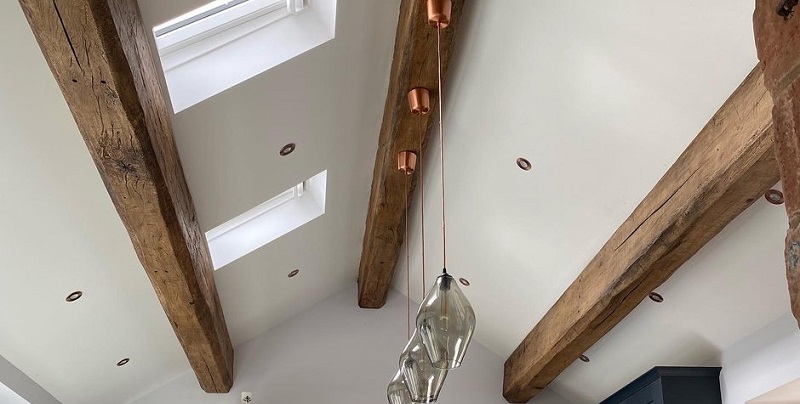
Aesthetic Advantages of Fiberglass Oak Beams
Fiberglass oak beams are designed to replicate the natural grain and texture of real oak, making them virtually indistinguishable from authentic wood beams once installed. This design feature allows homeowners to achieve the rustic charm and warmth that oak beams bring to a space. Whether installed on a ceiling or used as decorative accents on walls, fiberglass oak beams offer a high-end look that fits seamlessly into any interior design style, from modern to classic.
One of the significant benefits of fiberglass oak beams is their ability to maintain the same level of aesthetic appeal over time without the risk of warping, cracking, or decay. Traditional oak beams are susceptible to these issues, especially in humid environments, whereas fiberglass oak beams are resistant to such problems, making them an excellent long-term investment.
Applications of Fiberglass Oak Beams in Home Interiors
Fiberglass oak beams are incredibly versatile, Different from fiberglass porch beams are designed for outdoor use, fiberglass oak beams ideal for indoor decorative applications. lending themselves to various applications throughout the home. Here are some popular ways to incorporate them into interior spaces:
- Ceiling Beams: Adding fiberglass oak beams to the ceiling can instantly create a sense of depth and warmth. Whether arranged in a traditional grid pattern or spaced apart for a more modern look, ceiling beams enhance the architectural design of any room.
- Wall Accents: Fiberglass oak beams can be used as decorative accents on walls to add a rustic touch. Whether framing doorways or windows, they offer a striking visual element that complements the overall design of the space.
- Fireplace Mantels: A fiberglass oak beam as a mantelpiece above the fireplace can serve as a focal point in a living room or family room. The beam adds texture and character to the space without the need for heavy materials or complicated installations.
Versatility of Fiberglass Oak Beams in Architectural Styles
Fiberglass oak beams are suitable for various architectural styles, from traditional to contemporary. Their ability to blend seamlessly with different design aesthetics makes them a popular choice among architects and interior designers. In more traditional settings, these beams can be used to enhance the rustic charm of a space, while in modern designs, they can add an interesting contrast between sleek, minimalist lines and natural textures.
The Role of Fiberglass Oak Beams in Open Concept Designs
Open concept living spaces are a popular trend in modern homes, and fiberglass oak beams can play a key role in defining these areas. By adding beams to the ceiling, you can create visual separation between different zones, such as the kitchen, dining, and living areas, without the need for walls or partitions. This approach maintains the flow and openness of the space while adding architectural interest and warmth.
The Key of Fiberglass Oak Beams in Interior Design
Fiberglass oak beams are increasingly being used in interior design to enhance both traditional and contemporary spaces. They serve as a statement piece, adding depth and character to ceilings without the structural demands that come with real wood beams.
In addition to their aesthetic appeal, fiberglass oak beams are incredibly versatile. They can be adapted to fit various architectural styles, whether that means creating a rustic, farmhouse feel or adding a modern touch to an industrial design. Their flexibility makes them a popular choice for home renovations and new builds, as they can be seamlessly integrated into different room layouts and themes.
With fiberglass oak beams, homeowners can achieve the look of exposed wooden beams, which evoke a sense of warmth and history, without compromising on modern-day conveniences.
Why Choose Fake Wooden Beams for Ceiling Designs?
The appeal of fake wooden beams, especially fiberglass oak beams, lies in their ability to replicate the grandeur of traditional wood without the common pitfalls of real timber. Fiberglass Ceiling beams, in particular, are an architectural feature that can transform any room by adding visual interest and creating a sense of spaciousness.
In many older homes, exposed beams are a key feature, but installing real oak beams can be costly and labor-intensive. Fiberglass oak beams offer a simpler, more affordable alternative, while still delivering the visual impact homeowners desire. The beams are easy to handle and can be installed quickly, making them a favorite among contractors and DIY enthusiasts.
Moreover, fiberglass oak beams allow for endless design possibilities. Whether in large, open living spaces or smaller, more intimate rooms, these beams can be used to create unique ceiling patterns or simply add a touch of sophistication. Their versatility makes them suitable for both contemporary and traditional ceiling designs.
How Fiberglass Tie Beams Improve Structural Stability and Safety
Installation and Maintenance of Fiberglass Oak Beams
The durability of fiberglass oak beams is one of their key selling points. Unlike real oak, which requires regular maintenance such as sealing or treating to prevent deterioration, fiberglass oak beams are low-maintenance. They do not need to be refinished or protected from pests, moisture, or rot. This makes them especially suitable for high-humidity environments, such as bathrooms or kitchens, where wood might struggle to retain its quality.
Fiberglass oak beams also stand up well to changes in temperature and humidity, ensuring that they remain stable and intact even in areas with fluctuating weather conditions. The strength of fiberglass combined with its lightweight nature allows these beams to support various design elements without the need for additional structural support, which is often necessary with traditional oak beams.
Installation Process of Fiberglass Oak Beams
Installing fiberglass oak beams is a straightforward process, especially when compared to real wood beams. Due to their lightweight construction, fiberglass beams are easier to handle and install, whether by a professional contractor or a skilled DIYer.
Fiberglass oak beams can be installed on various types of ceilings, including drywall, plaster, or wood. Depending on the size and layout of the room, beams can be arranged in different patterns, such as running parallel across the ceiling or intersecting to form a coffered ceiling design.
The ease of installation not only saves time but also reduces labor costs. Since fiberglass oak beams do not require heavy machinery or reinforcement of the ceiling structure, they are an affordable option for those looking to enhance their home’s interior without significant construction work.
One of the most significant advantages of using fiberglass oak beams is the ease of installation. Because they are much lighter than real wood beams, fiberglass oak beams can be installed without requiring heavy-duty equipment or extensive manpower. This allows for a more straightforward and cost-effective installation process, reducing labor costs and time.
Fiberglass oak beams can be installed in both new constructions and renovations. Their lightweight construction makes them perfect for older homes where the ceiling may not support the weight of traditional wood beams. Additionally, these beams can be cut and shaped to fit specific dimensions, making them highly customizable for unique spaces.
Maintenance of Fiberglass Oak Beams
One of the standout features of fiberglass oak beams is their minimal maintenance requirements. Unlike real wood, which needs to be treated periodically to protect against moisture, rot, and insects, fiberglass beams are virtually maintenance-free.
Fiberglass oak beams are designed to retain their color and appearance over time, even when exposed to varying environmental conditions. A simple dusting or wipe down with a damp cloth is all that is needed to keep them looking fresh and new. This makes them an excellent choice for homeowners who want the beauty of oak without the hassle of ongoing upkeep.
Additionally, fiberglass oak beams are resistant to fading, so they maintain their vibrant, wood-like appearance for years, even in rooms with a lot of natural sunlight. This makes them a practical solution for both indoor and outdoor applications.
Why Choose Fiberglass Oak Beams?
Fiberglass oak beams are an excellent choice for homeowners who want the classic look of oak without the maintenance and structural challenges that come with traditional wood beams. With their durability, ease of installation, and versatility in design, these beams offer a practical solution that doesn’t sacrifice aesthetics. Whether you are renovating an older home or building a new one, fiberglass oak beams can provide the perfect finishing touch to your interior or exterior design.
By incorporating fiberglass oak beams into your space, you can achieve the timeless beauty of oak while enjoying the benefits of modern materials.
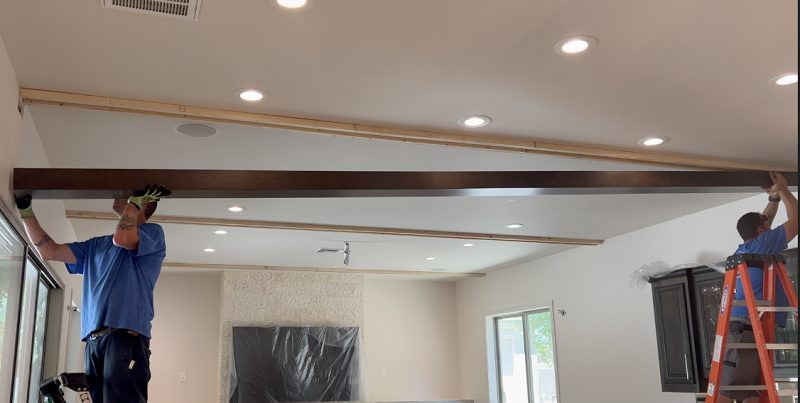
Environmental Benefits of Fiberglass Oak Beams
The production of fiberglass oak beams is also more environmentally friendly compared to harvesting natural oak wood. The manufacturing process uses fewer natural resources and reduces the demand for deforestation, which has significant environmental implications. By choosing fiberglass oak beams, homeowners can enjoy the beauty of oak without contributing to the depletion of natural forests.
Additionally, the lightweight nature of fiberglass oak beams means that less energy is required for transportation, further reducing their environmental footprint. The long-lasting durability of fiberglass oak beams also means fewer replacements over time, which contributes to less waste and a more sustainable building material option.
Cost-Effectiveness of Fiberglass Oak Beams
When compared to traditional oak beams, fiberglass oak beams are often more cost-effective. The lower cost of materials, combined with reduced installation expenses, makes fiberglass oak beams an affordable option for homeowners looking to add architectural interest to their homes. Additionally, because these beams require little to no maintenance, they offer long-term savings over the lifespan of the product.
Eco-Friendly Benefits of Fiberglass Oak Beams
In today’s environmentally conscious world, more homeowners are seeking sustainable building materials. Fiberglass oak beams, similar to faux fiberglass beams, provide an eco-friendly alternative to real wood, as they are made from fiberglass, a more sustainable material than harvested oak. By choosing fiberglass oak beams, homeowners are helping to preserve oak trees and reduce deforestation.
Furthermore, fiberglass oak beams do not require the use of harmful chemicals or treatments to protect against pests and moisture, making them a safer option for both the environment and the home. The long-lasting nature of fiberglass also means fewer resources are needed for repairs or replacements, contributing to a more sustainable home design.
Fiberglass Oak Beams: The Perfect Blend of Beauty and Functionality
Fiberglass oak beams combine the best of both worlds—offering the timeless beauty of oak wood with the durability and low maintenance of fiberglass. Whether used in indoor or outdoor settings, these beams provide an affordable, sustainable, and stylish solution for homeowners looking to add character and charm to their living spaces. With their versatility, ease of installation, and long-lasting performance, fiberglass oak beams are the perfect choice for any design project.
Fiberglass Oak Beams for Outdoor Spaces
Fiberglass oak beams are not limited to indoor applications. They can also be used in outdoor spaces, such as patios or pergolas, where the look of wood is desired but the durability of fiberglass is necessary to withstand the elements. These beams are resistant to UV rays, moisture, and temperature fluctuations, making them ideal for exterior use without compromising on appearance.
Fiberglass Oak Beams in Outdoor Spaces
Fiberglass oak beams are not limited to indoor applications. They can also be used in outdoor spaces, such as patios, pergolas, and garden structures. Their resistance to moisture, pests, and UV rays makes them a durable option for exterior design projects.
In outdoor spaces, fiberglass oak beams can create a rustic, natural look without the worry of weather-related damage that often affects real wood. Whether used to support a patio roof or simply as a decorative element, fiberglass oak beams can enhance the beauty of outdoor areas while offering long-lasting performance.
Fiberglass Oak Beams: A Modern Alternative to Traditional Wood
Fiberglass oak beams offer a modern alternative to traditional wooden beams, combining the natural beauty of oak with advanced material benefits. While traditional wood beams bring a classic aesthetic, they often require extensive maintenance and can be prone to issues like warping, cracking, or insect damage. Fiberglass oak beams, on the other hand, are engineered for longevity and minimal upkeep, making them a practical choice for a variety of interior and exterior applications. Below is a detailed comparison of fiberglass oak beams and traditional wood, highlighting their key differences and the impact of each on performance, aesthetics, and usability.
| Feature | Fiberglass Oak Beams | Traditional Wood Beams | Impact |
|---|---|---|---|
| Aesthetics | Realistic oak grain and texture, customizable finishes | Authentic oak appearance but with natural variations | Fiberglass beams offer consistent aesthetics with less variation and more customization options. |
| Durability | Resistant to warping, cracking, and insect damage | Prone to warping, cracking, and susceptible to termites or pests | Fiberglass beams are ideal for long-term use, especially in humid or pest-prone areas. |
| Maintenance | Virtually maintenance-free, easy to clean | Requires regular sealing, sanding, and inspections | Fiberglass beams save time and cost in upkeep compared to traditional wood. |
| Moisture Resistance | Impermeable to water, resistant to mold and mildew | Absorbs moisture, can rot or develop mold in damp environments | Ideal for bathrooms, kitchens, or outdoor use, fiberglass beams eliminate concerns about water damage. |
| Weight | Lightweight, easy to install | Heavy, requires additional support during installation | Fiberglass beams reduce labor and installation costs while being suitable for a wide range of applications. |
| Flame Resistance | Naturally flame-retardant | Flammable, requires treatments for fire resistance | Fiberglass beams offer enhanced safety, particularly in fire-prone areas or commercial settings. |
| Longevity | Designed for decades of use with consistent performance | Lifespan depends on maintenance and environmental conditions | Fiberglass beams provide a longer-lasting solution with consistent quality. |
| Cost | Higher initial cost but lower maintenance expenses over time | Lower initial cost but higher maintenance and potential repair expenses | Fiberglass beams are a cost-effective investment when considering long-term durability and reduced maintenance needs. |
This comparison highlights how fiberglass oak beams deliver superior performance in areas where traditional wood beams fall short. With their blend of style, durability, and practicality, fiberglass oak beams are redefining design possibilities for modern interiors and exteriors.
Tools and Adhesives for Bonding Fiberglass Two Beams Together
FAQs about Fiberglass Oak Beams
Yes, oak beams can sometimes be used instead of RSJs (Rolled Steel Joists), but it largely depends on the structural requirements of the project. RSJs are often used in modern construction due to their immense strength and ability to support heavy loads over long spans, which is particularly useful in open-plan spaces or when creating large openings in walls. Oak beams, while strong, may not always provide the same level of load-bearing capacity as an RSJ, especially over long spans or in high-stress areas.
In some cases, oak beams are chosen for their aesthetic appeal, and they can be engineered to carry significant loads with the right support. However, for larger projects or where maximum strength is critical, RSJs are usually preferred. That said, oak beams can still be used decoratively alongside RSJs to achieve a rustic look while the RSJ provides the necessary structural support. Always consult a structural engineer to determine if oak beams can safely replace an RSJ in a particular project.
Fiberglass beams are an increasingly popular alternative to oak beams, offering both strength and durability without the maintenance required by wood. Unlike oak, fiberglass is resistant to moisture, rot, and pests, making it ideal for outdoor applications or in environments where humidity and weathering might be an issue. Fiberglass beams can be designed to mimic the appearance of wood, providing the aesthetic benefits of oak without the associated upkeep.
For those looking for a different wood alternative, softwoods like pine or Douglas fir can also be used, although they lack the density and long-term durability of oak. Laminated veneer lumber (LVL) is another viable option, offering structural integrity while being more affordable than oak. LVL beams are engineered wood products designed for load-bearing applications, and they provide consistency in performance, making them a good alternative for modern construction. Ultimately, the choice of an alternative depends on the specific project needs and aesthetic preferences.
The best treatment for oak beams largely depends on whether the beams will be used indoors or outdoors and the aesthetic goals of the project. For indoor oak beams, oil or wax finishes are often recommended to protect the wood while enhancing its natural beauty. These treatments help to nourish the wood, preventing it from drying out or cracking over time. Popular choices include linseed oil and beeswax, both of which penetrate deep into the wood and provide long-lasting protection.
For outdoor oak beams, it’s important to use a treatment that protects against moisture, UV exposure, and fungal decay. A good exterior wood preservative or oil is ideal for sealing the oak and ensuring it stands up to the elements. Regular maintenance, such as reapplying oil or preservative, will help maintain the beam’s strength and appearance over time. Additionally, for oak beams exposed to excessive moisture or humidity, a fungicide treatment may be recommended to prevent mold or mildew growth.
For fiberglass oak beams, the best finish replicates the natural appearance of authentic oak while providing durability and protection. High-quality polyurethane coatings or specialized faux wood finishes are excellent choices. These finishes enhance the beam’s texture and color, ensuring a realistic oak look. Fiberglass oak beams are often pre-finished, but additional finishes can be applied to match your interior design or to provide added UV protection for outdoor use. Satin or matte finishes are popular for maintaining a natural wood aesthetic. Maintenance involves occasional cleaning with mild products to preserve the finish. Unlike real oak, fiberglass beams do not require sanding, sealing, or frequent re-finishing, making them a low-maintenance option. The right finish for fiberglass oak beams balances aesthetics with practical durability, ensuring long-lasting visual appeal in both interior and exterior settings.
Adding faux beams, including fiberglass oak beams, typically costs between $10 and $30 per linear foot, depending on the quality and customization. For a standard room, the total cost may range from $300 to $2,000, factoring in labor and installation. Fiberglass beams are lightweight and easy to install, reducing labor costs compared to heavier materials like real wood. Custom finishes, intricate designs, or unique dimensions can increase the price. Fiberglass oak beams offer excellent value as they replicate the look of authentic oak without the high cost of real wood beams or structural modifications. Installation involves securing the lightweight beams to existing structures, making them an ideal choice for renovations or adding character to ceilings and walls. Consult a professional to get an accurate estimate based on your space and design preferences.
Shakes in natural oak beams are small splits or cracks that occur due to drying and aging of the wood. However, fiberglass oak beams are engineered to mimic the appearance of real oak, including subtle shake-like textures, without structural flaws. These features are purely aesthetic, crafted into the fiberglass to enhance the realistic look of the beam. Unlike real wood, fiberglass beams do not expand, contract, or crack over time, ensuring durability and consistent appearance. This makes fiberglass oak beams a superior choice for those seeking the charm of authentic oak without the maintenance or risks associated with natural wood imperfections. The absence of true shakes in fiberglass beams means they retain their visual appeal and structural integrity for years, making them a cost-effective and low-maintenance alternative.
LVL (Laminated Veneer Lumber) beams are generally more expensive than faux options like fiberglass oak beams. LVL beams, designed for structural support, cost approximately $3 to $12 per linear foot based on size and grade. Fiberglass oak beams, by comparison, are decorative and more affordable, priced between $10 and $30 per linear foot, with significantly lower installation costs due to their lightweight nature. While LVL beams are essential for load-bearing applications, fiberglass oak beams are an excellent choice for aesthetic purposes, offering the timeless charm of oak without the weight, cost, or structural complexities. Fiberglass beams are also easier to customize, maintain, and install, making them a practical option for adding style and character to a space without the expense or engineering requirements of LVL beams.
Swirls in wood are known as “grain patterns,” resulting from the tree’s growth rings and natural fibers. Fiberglass oak beams replicate these intricate grain patterns, mimicking the swirls and textures found in authentic oak. Advanced manufacturing techniques create realistic patterns, ensuring that fiberglass beams closely resemble natural wood without the imperfections. These swirls add depth and character to the beams, enhancing their aesthetic appeal. Unlike real wood, which may have unpredictable grain variations, fiberglass oak beams offer consistent and customizable patterns, ensuring a uniform appearance. This makes them an ideal choice for achieving the look of natural oak without the challenges of working with real wood, such as warping or cracking. Fiberglass beams deliver the beauty of grain patterns with added durability and ease of maintenance, making them a versatile decorative option.

As the editor of GangLong Fiberglass, I have years of experience and in-depth research, focusing on cable tray products, fiberglass solutions, and grille systems. I incorporate years of industry insights and practical experience into every content, committed to promoting the progress of the industry. At GangLong Fiberglass, my commitment is reflected in every product, from innovative cable trays to durable fiberglass solutions and sturdy grille systems. As an authoritative voice in the industry, my goal is to provide valuable information to professionals and businesses and promote forward-looking solutions.

